WHEN RARE ISN’T A STRONG ENOUGH WORD
This Thanksgiving, an Apex family is grateful for the relentlessness of an NC State veterinary resident, the skill of a UNC 'human' physician and the willingness of other heroes to help forge the fantastical story of Winston.
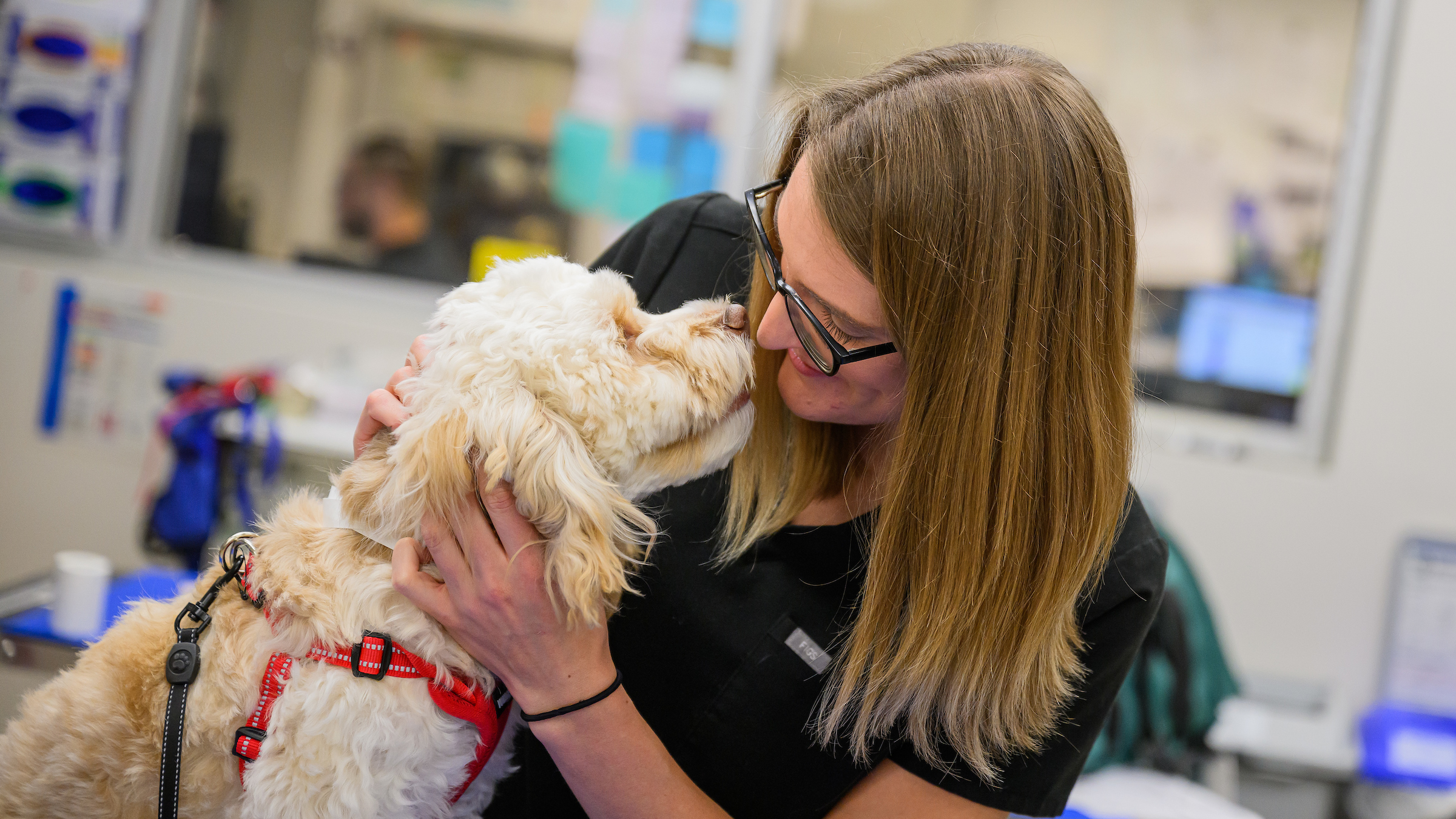
By Burgetta Eplin Wheeler
When Dr. Todd Baron, a professor of medicine and gastroenterologist at UNC Hospital-Chapel Hill, arrived at the NC State Veterinary Hospital to treat an ailing cockapoo puppy, he was about to perform a life-saving procedure no one likely had ever used on a dog before.
And the puppy, named Winston, had a rare pancreatic condition that no one at NC State could recall seeing before.
Winston, as owner Bill Kivett says today, is alive to see his first birthday in January only because the medical sun and the moon and all of the planets perfectly aligned.
The sun in this case is NC State veterinary resident Dr. Katie Anderson, the moon “human” doctor Baron and the planets a host of moving parts including a piece of medical equipment so rare and expensive that it had to be rented from the manufacturer.
In April, Kivett and wife Stacy had brought Winston, born in January in Winston-Salem, home to their two sons in Apex. Within a few weeks, the pup started having episodes of vomiting and lethargy that resulted in multiple visits to local veterinary emergency hospitals.
“He literally wouldn’t move from one spot,” Stacy Kivett recalls. “That’s what triggered us to take him in. He wasn’t moving, and when we did pick him up, he was wincing in pain. He was a little bitty thing, maybe 6 or 8 pounds.”
About every two weeks, the pup would have another episode, always after hours on a Saturday, the Kivetts joke. Winston, who loves to take rides in the car, would perk up after receiving intravenous fluids at whatever local emergency hospital could see him, and the Kivetts would be advised to follow up with their primary care veterinarian.
Of course, Winston always seemed fine during the followup appointments, the Kivetts say, but their veterinarian did suggest that Winston might be suffering from pancreatitis, which would be uncommon in a puppy.
‘It was a strange history’
On a Saturday in June, Winston had a particularly bad episode, and the Kivetts took him to a local veterinary emergency hospital, which referred him to the NC State Veterinary Hospital at the College of Veterinary Medicine.
The on-call resident in internal medicine that weekend was Anderson, who took the dog’s history from the Kivetts.
“It was a strange history,” says Anderson, a DVM graduate of the University of Minnesota in her third year of residency at NC State. “We did a diagnostic workup for gastrointestinal disease trying to figure out what was going on. We evaluated bloodwork and an abdominal ultrasound. We determined he was having recurring episodes of pancreatitis, and this was surprising and unexpected. You just don’t see that in a dog this young.”
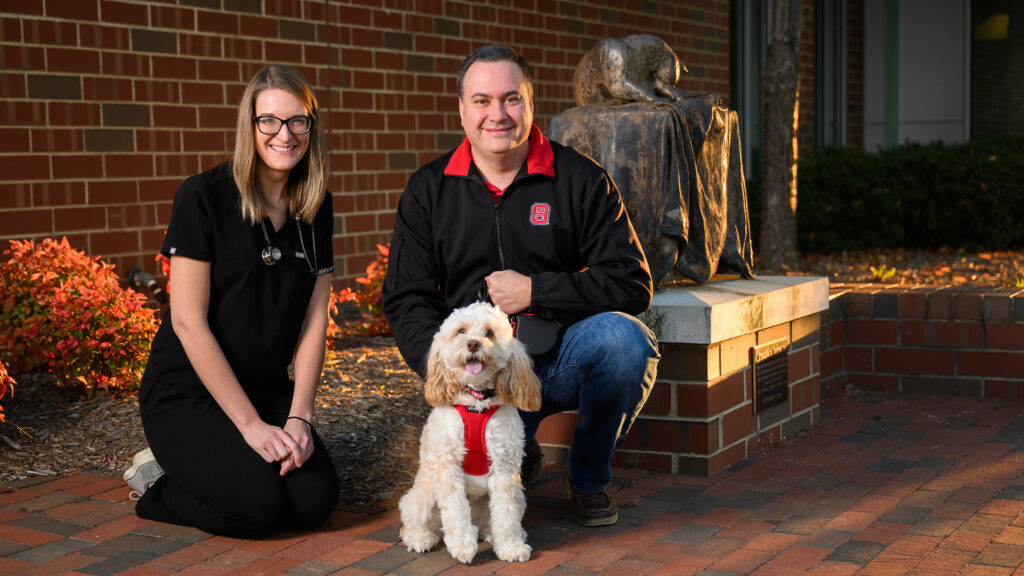
Anderson says she stayed awake for hours that night reading through the medical literature on juvenile pancreatitis in humans because there simply was no literature on the condition in puppies. Pancreatitis, or inflammation of the pancreas, is usually a disease of the middle-aged and elderly, even in dogs.
“The thing I kept running across was this congenital abnormality,” she says. “The pancreas has a little duct that leads down to the intestine, and at the entrance to the intestine is a sphincter that’s usually closed. When the pancreas releases enzymes, the sphincter is supposed to open and allow them to empty into the intestine.”
When the sphincter doesn’t open properly, the fluid backs up into the pancreas and can cause recurrent pancreatitis, she says. It can also cause the duct to become dilated, and Anderson was able to see a dilation in Winston’s duct because of NC State’s state-of-the-art equipment.
“This is how we ended up diagnosing him with this disease,” she says. “It’s called Wirsungocele if the major duodenal papilla is affected or Santorinicele if the minor duodenal papilla is affected in people.”
Canine anatomy is slightly different, but Winston naturally had the less common abnormality.
“The message we got initially was that Dr. Anderson had literally never seen anything like this before. Ever,” Stacy Kivett says. “She had never seen it. She consulted with many, many doctors, radiology, and they had never seen it. Ever. We were, like, of course you haven’t.”
Diagnosis in hand, the next obstacle was figuring out how to treat it.
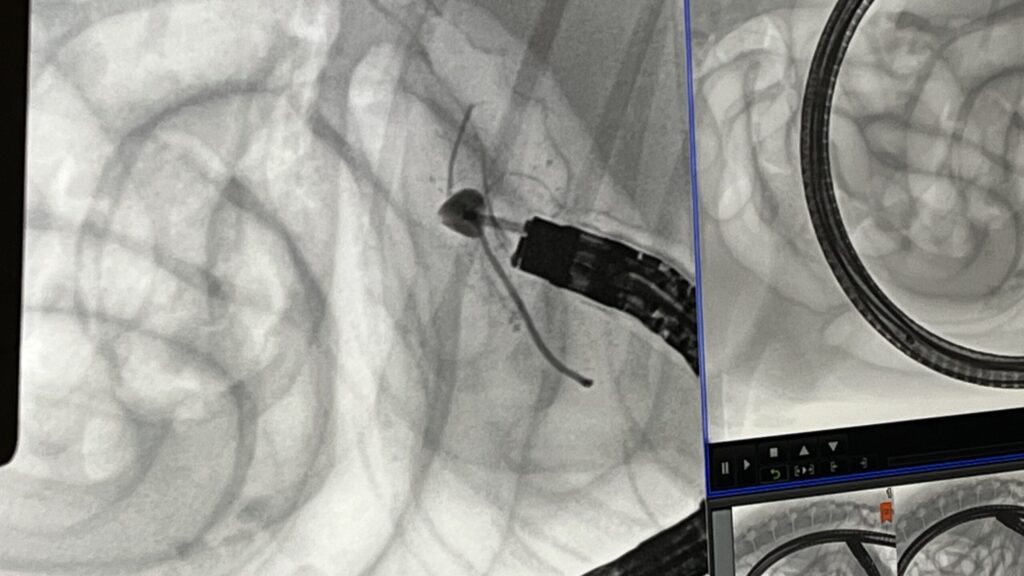
The protocol in humans requires using a special endoscope, made by Olympus, that has a side-facing rather than forward-facing camera to better see the tiny pancreatic ducts, says Dr. Jody Gookin, a professor of internal medicine at NC State. Only two pediatric-sized Olympus scopes exist, Baron says.
“These endoscopes are designed to be able to find these ducts and actually catheterize these sphincters in people,” says Gookin, Fluoroscience Distinguished Professor of Veterinary Research Education. “The use of these scopes enables us to do what’s called a sphincterotomy to open the obstructed duct to cure these patients. It’s something we just don’t have in veterinary medicine.”
He wrote the book
Because Gookin is part of the Center for Gastrointestinal Biology and Disease, a collaborative GI research center at UNC-Chapel Hill and NC State University, she sought advice from a colleague there. The center is funded by the National Institutes of Health and focuses on the microbiome, clinical and translational research, and regenerative medicine and repair.
“The center provides a unique resource for clinical and research collaboration between veterinary and human gastroenterologists that goes both ways,” Gookin says. “I reached out to a colleague at the UNC-Chapel Hill human hospital and asked if he knew anyone with any expertise in using this scope. The procedure is called ERCP or endoscopic retrograde cholangiopancreatography.”
It just so happens that her colleague knew Baron, director of Advanced Therapeutic Endoscopy at the University of North Carolina at Chapel Hill. Baron, who has been doing complex endoscopy since 1993, wrote the book on ERCP. It’s in its fourth edition.
“They gave us Dr. Baron’s contact info, and we had a conference call that same afternoon,” Anderson says. “We said, ‘Do you think this is a possibility?’ And he said, ‘Yes, absolutely, that’s what’s going on with this dog.’ We talked about surgical options, and he just offered to come and bring the equipment and do the procedure for us. He was incredibly generous, incredibly kind.”
The Kivetts were stunned by the offer.
“We were jokingly saying we’d have to wheel him into Rex Hospital or UNC with a tail coming out of his gown,” Stacy Kivett says. “But Dr. Baron came to NC State!”
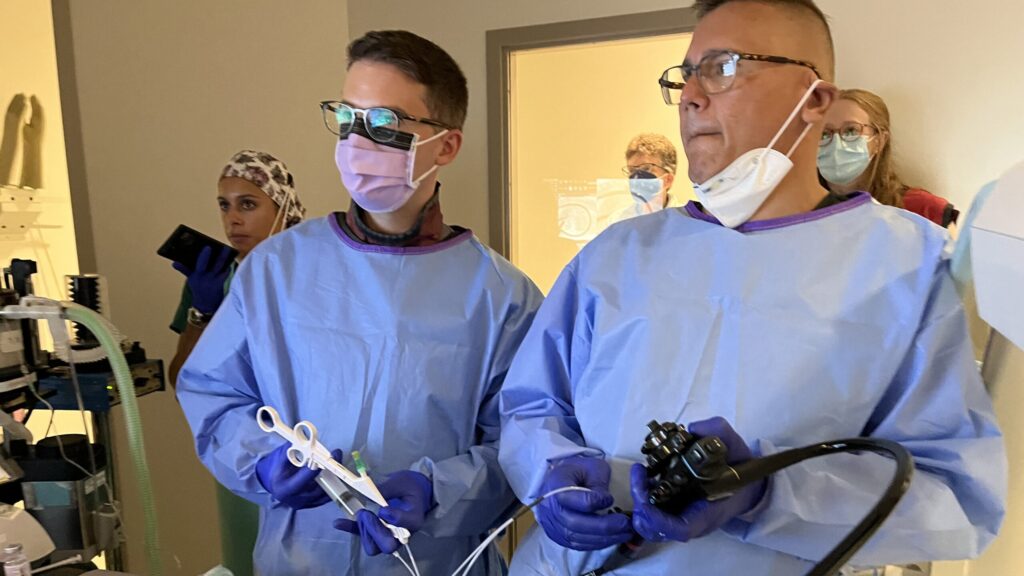
On a Wednesday in July, Baron arrived at NC State with an adult-sized endoscope in hand. Used to maneuvering the scope through 200-pound humans, Baron says it was surreal when he walked into the procedure room and actually looked down at tiny Winston.
“It was a little bit of bewilderment, and it wasn’t lost on me that this dog was important to somebody,” he says. “I didn’t look at it as just an animal. You put yourself in the place of the owner, and it’s their family member. I thought about it the same way I do when I do this procedure on a person. It’s not an inanimate object. They have feelings and family members. What I do doesn’t affect only the person but all of the people who depend on and love that person.”
Once he had guided the special endoscope with the side camera into place through Winston’s esophagus, Baron discovered that the adult-sized instrument was too large, obstructing his view.
“We switched back to a standard scope that doesn’t have the same capabilities,” he says, “but through ingenuity we were able to complete the procedure and open the duct with a cutting instrument so it would drain better.”
The “we” was Baron and the staff at the NC State Veterinary Hospital. Baron was the only “human” clinician there, although a representative from the scope manufacturer also attended to witness the never-before-seen use on a dog.
‘A real team effort’
Gookin says the veterinary college had several conversations and planning sessions with Baron before the procedure was scheduled and also coordinated with Winston’s owners.
“We got the dog here, we put the dog under anesthesia, then it was all done under fluoroscopy where we can see where the scope is and anatomy in real time,” says Gookin, who particularly praised the work of Patty Secoura, an experienced internal medicine veterinary technician. “Dr. Baron was able to put contrast media in one of the pancreatic ducts to highlight what was going on, identify the site of the obstruction and use the scope to perform a sphincterotomy. The patient has recovered extremely well.”
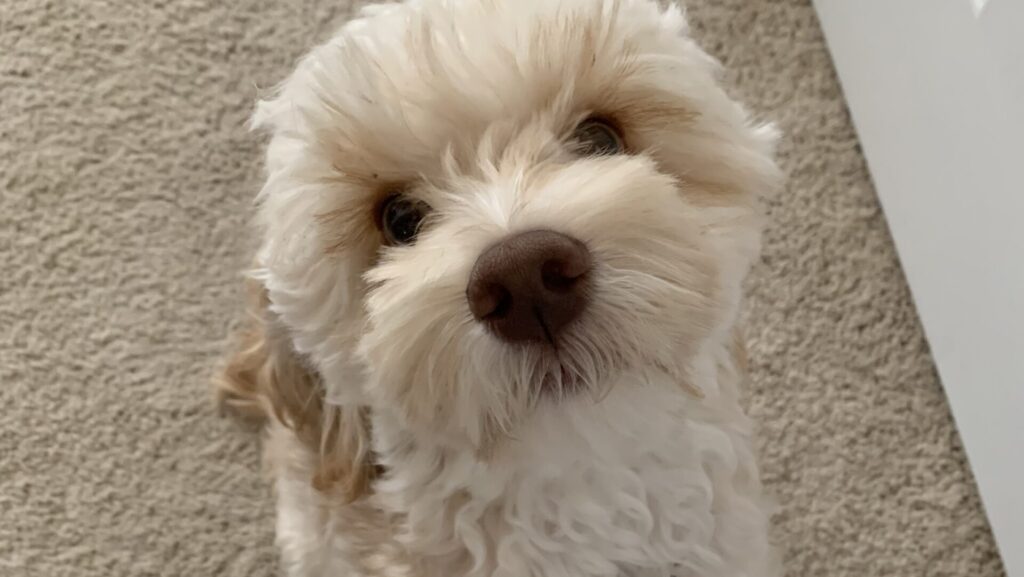
The veterinary medical facilities were top-notch, and the high-level imaging equipment was vital to completing the procedure successfully, Baron says.
“It wasn’t just me looking on the inside,” he says. “We needed the imaging equipment to be high resolution because we injected the pancreas duct with contrast to find the openings. It was a real team effort.”
And the team, Baron and Anderson are quick to point out, includes the Kivetts.
“They were probably the best owners to be involved with this case,” Anderson says. “It’s hard when doctors tell you we’ve never seen this condition before, we think this is what’s going on, but we don’t know for sure. We’re going to do this uncommon procedure that may or may not fix your dog. They were amazing and very open to trying anything that worked.”
For the Kivetts, both of whom graduated from NC State University in 2000, the fact that Winston has had no more painful episodes since the procedure in July is everything.
“Dr. Anderson and her team went above and beyond anything either one of us could have ever imagined to really figure out what was going on with Winston,” Bill Kivett says. “It wasn’t a check the box exercise. I don’t think we can express our gratitude enough to everybody who has helped out, everything that’s happened from the first time we took him to NC State until today.”
The most astonishing thing to Baron was all of the pieces coming together. He found Bill Kivett’s sun and moon and planets analogy apt.
“The biggest things are the collaboration around the two universities, the willingness of everyone to really pitch in,” Baron says. “It was very exciting obviously because we were doing something very novel, something other institutions in the country really couldn’t provide. And we had the good fortune to have everything work out.”
Against all odds, Winston today is taking the car rides he loves and playing hide and go seek the ball with the Kivett boys. And, the next time the family takes a beach trip, Stacy Kivett says, her pup will be sitting on the balcony, face to the wind, ears just flapping away.
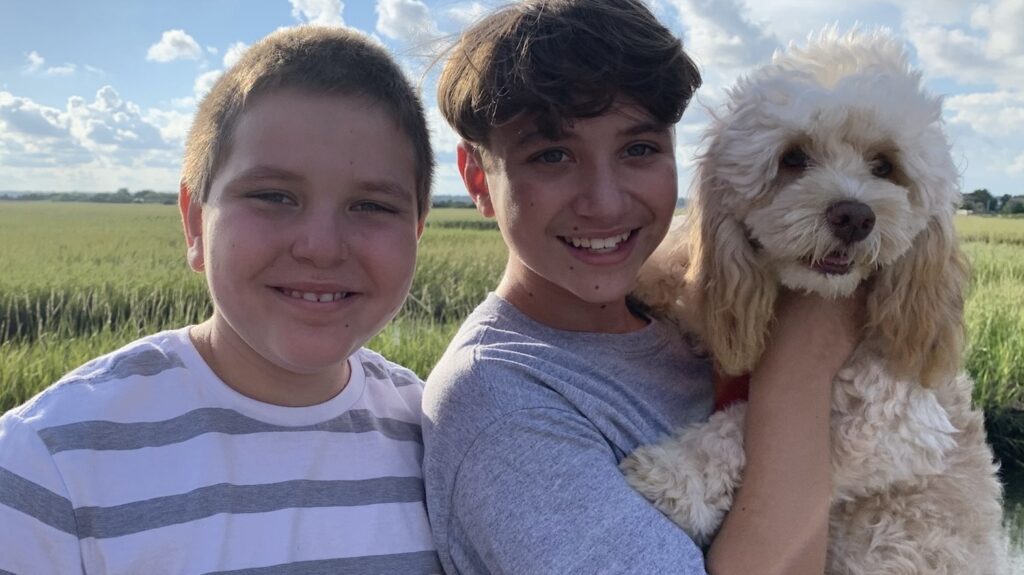
- Categories:


